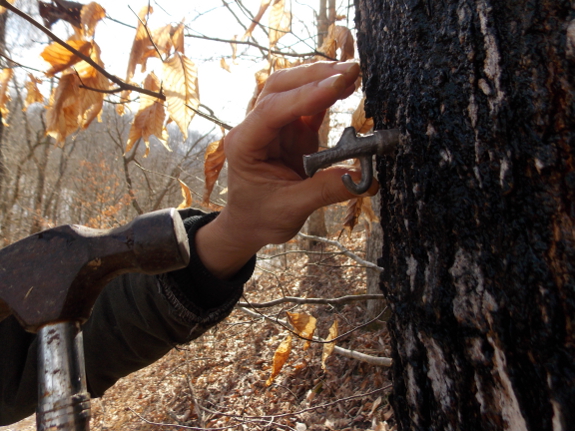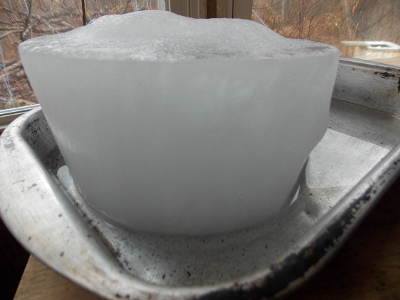
Concentrating maple sap through freezing

When I posted about the potential for feeding maple sap to bees,
two of our readers made the suggestion of utilizing freeze
concentration to increase the proportion of sugar in the sap without
causing bee indigestion by heating the sap to the boiling point.
Mark thought I was breaking the laws of physics until I explained that
freeze concentration is just a method of separating most of the sugars
from some of the water, resulting in a smaller quantity of liquid that's
sweeter than what you started with.
Depending on who you talk
to, you can capture 70% to 90% of the sugars in maple sap in 16.5% of
the volume through one to two rounds of freezing and thawing. If
your area gets below freezing at night, simply leave your sap outside
or, if you're enjoying a warm spell like we are, put a bucket of sap in
your chest freezer overnight. After freezing, let the  block
of ice sit at room temperature until about a third of its bulk has
melted --- that's the precious sugar portion. Toss the ice and put
the sugary sap back in the freezer for a repeat freeze-thaw cycle, this
time keeping the first half of the melted liquid. The result
should be a liquid that has increased from 1-3% sugar to 5-16%
sugar. (You'll also have some frozen sap-water to turn into Appalachian ice sculptures.)
block
of ice sit at room temperature until about a third of its bulk has
melted --- that's the precious sugar portion. Toss the ice and put
the sugary sap back in the freezer for a repeat freeze-thaw cycle, this
time keeping the first half of the melted liquid. The result
should be a liquid that has increased from 1-3% sugar to 5-16%
sugar. (You'll also have some frozen sap-water to turn into Appalachian ice sculptures.)
According to some
sources, freeze concentration is a great way to start making maple
syrup, as well as for concentrating maple sap for bees. Freezing
generally uses less energy than boiling off the same quantity of water
(especially if you can just put your sap outside to freeze), and you
won't have to deal with the excessive steam clogging up your
kitchen. However, scientists recommend planning on utilizing
boiling to turn your sap concentrate into a real maple syrup since the
chemicals that produce the color, flavor, and odor of maple syrup are
formed through the application of heat. Plus, you need to get rid
of enough liquid to bring your sap to at least 66% sugar when making
maple syrup, which would take quite a few rounds of freezing and
thawing.
We'll be trying out our
first batch of maple-sap concentrate on our bees, but will boil the next
batch down into syrup on top of our wood stove. Stay tuned for
more information in later posts.
Want more in-depth information? Browse through our books.
Or explore more posts by date or by subject.
About us: Anna Hess and Mark Hamilton spent over a decade living self-sufficiently in the mountains of Virginia before moving north to start over from scratch in the foothills of Ohio. They've experimented with permaculture, no-till gardening, trailersteading, home-based microbusinesses and much more, writing about their adventures in both blogs and books.
Want to be notified when new comments are posted on this page? Click on the RSS button after you add a comment to subscribe to the comment feed, or simply check the box beside "email replies to me" while writing your comment.

Your website came up in a google search so I read the article. The very reason I was searching is because I had tapped and produced about 60 gallons of sap this year but in Minnesota our first sap run was only a week and the temps fell hard to negatives and my sap froze in place. I brought the buckets of ice inside my house and let them thaw before boiling out the water. They took quite awhile to thaw, about a week. My daughter likes to taste the sap right in a glass of water so like usual, I let her have a glass.
The look on her face was one of confusion as she had brought friends out from the neighbors and had bragged up how good the water tastes. I then tried it and sure enough it tasted of plain water. No Maple flavor AT ALL.
I opened more sap buckets and all had the same result. I was thinking maybe sugar levels were low in some trees etc.
One of the girls said, I wonder if the sweet water is at the bottom. I was about to say, no, that doesn't make sense, when I decided to test her theory. 10 year olds have awesome insight. So I poured half a 5 gallon bucket out slowly and let the girls dip their glasses again. Their faces lit up. Sweet maple sap!
I then took a spoon and stired one of the other buckets we had tried, it was now sweet again.
So, here I am on the net trying to find evidence that we were onto something! Separating the maple sugar from the water by freezing. Alas your post didn't confirm it as my maple sap was totally thawed. I do have a theory that based on your article, the sugar water, if cold enough sinks as it would be heavier and since it freezes last, it must thaw at a different rate as well in a layer! If undisturbed one in theory could pour off the top!
Now to test!!!
I don't know if Ian Osborne will ever see this, but in case someone else reads through and comes upon his daughters' insights, what happened is the creation of a density gradient. It's not uncommon and is surprisingly stable in liquids.
As the ice in your buckets melted, the part containing the bulk of the sugar melted first, yielding a relatively dense, sweet liquid. The later, nearly pure, ice slowly and gently melted over the top of it, creating a second layer of less dense water. Given several days to sit, the two layers would eventually diffuse into one another. If this were done in a clear container you'd even be able to see the different layers because of the difference in the way that they bend light.
It will never happen in the other direction though; you won't get the sugar at the bottom of the bucket by allowing it to be still and cold. That requires some significant outside intervention (freezing, R/O filtering, boiling, that sort of thing.)
You've likely seen something similar if you've ever put sugar in a glass of iced tea and not stirred. The sugar dissolves in the tea at the bottom of the glass and it makes a layer of syrup that flows around the bottom as you tip the glass back and forth, but it doesn't readily spread throughout the rest of the glass without stirring.